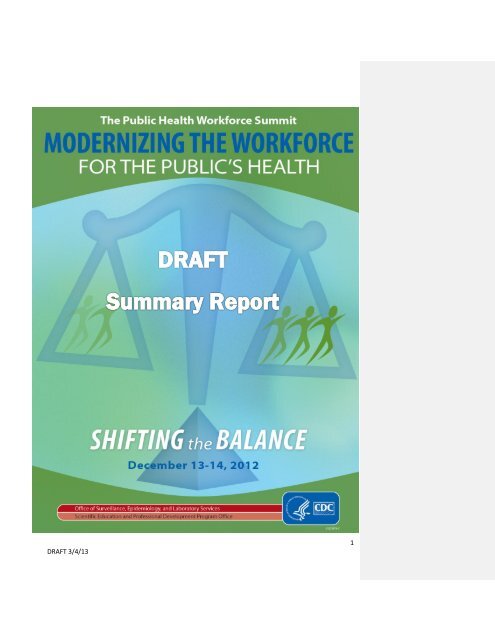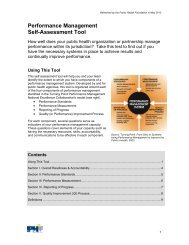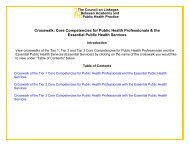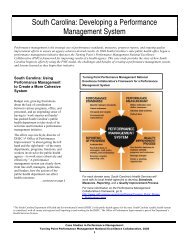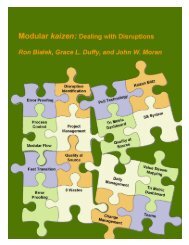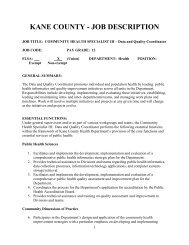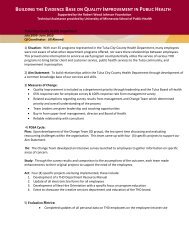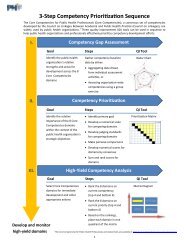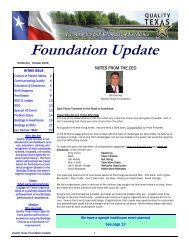1 DRAFT 3/4/13 - Public Health Foundation
1 DRAFT 3/4/13 - Public Health Foundation
1 DRAFT 3/4/13 - Public Health Foundation
Create successful ePaper yourself
Turn your PDF publications into a flip-book with our unique Google optimized e-Paper software.
<strong>DRAFT</strong> 3/4/<strong>13</strong><br />
1
Introduction<br />
On December <strong>13</strong> - 14, 2012, the Scientific Education and Professional Development Program<br />
Office (SEPDPO), Office of Surveillance, Epidemiology, and Laboratory Services (OSELS),<br />
Centers for Disease Control and Prevention (CDC) convened the <strong>Public</strong> <strong>Health</strong> Workforce<br />
Summit, Modernizing the Workforce for the <strong>Public</strong>’s <strong>Health</strong>: Shifting the Balance. Over 90<br />
Summit participants represented over 40 organizations, including CDC Centers, Institutes, and<br />
Offices (CIOs), the <strong>Health</strong> Resources and Services Administration (HRSA), public health<br />
practice organizations, academic associations, healthcare disciplines, nonprofit associations,<br />
and foundations.<br />
SEPDPO held the Summit as part of our <strong>Public</strong> <strong>Health</strong> Workforce Development Initiative<br />
(http://www.cdc.gov/osels/sepdpo/strategic-workforce-activities.html), established in spring<br />
2011, to engage partners about changes in public health and the related effects on the<br />
workforce. Through a series of conversations with multiple stakeholders—many of whom<br />
participated in the Summit—the following common themes emerged.<br />
<br />
<br />
<br />
The ongoing transformation of or “new” public health includes:<br />
a community focus, as well as a state-based focus<br />
dealing with voluminous information from multiple sources<br />
engaging more stakeholders<br />
navigating new territory given the impact (short- and long-term) of health reform<br />
developing stronger linkages to health care and health care delivery<br />
more monitoring and measuring<br />
The need to modernize the public health workforce, which includes (but is not limited to):<br />
Training for contemporary skills such as informatics and use of technology, leadership,<br />
business processes, community organizing and mobilization, and marketing<br />
Cross-training and mentorship, which are critical because of high turn-over and<br />
increasing mobility<br />
Increasing population health content in health professional curricula<br />
Expanding career pathways to attract new talent and varying skill sets<br />
CDC’s role during these changing times should be to:<br />
act as leader and convener, not necessarily to do all the work but to ensure that it gets<br />
done, through partnerships and collaborations across multiple constituencies<br />
engage all stakeholders, including those not traditionally regarded as being involved in<br />
public health, to bolster the reach and impact of our combined efforts<br />
SEPDPO used these themes as our starting point to develop the Summit agenda and to focus<br />
both the presentations and the highly interactive break-out sessions. We also created a visual<br />
roadmap, the National <strong>Public</strong> <strong>Health</strong> Workforce Strategy Roadmap (on page 4), with four highlevel<br />
goals and corresponding strategies, as well as cross-cutting strategies to support the four<br />
goals. The Roadmap served as the framework for the Summit breakout discussions. Prior to the<br />
Summit, participants had the opportunity to provide comments on the Roadmap and to rank the<br />
importance of the strategies for each goal.<br />
<strong>DRAFT</strong> 3/4/<strong>13</strong><br />
2
SEPDPO will use the Summit recommendations and the Roadmap as the foundation for<br />
continuing to engage stakeholders to develop a National <strong>Public</strong> <strong>Health</strong> Workforce Strategy<br />
during 20<strong>13</strong> that will:<br />
<br />
<br />
<br />
<br />
Include a coordinated plan of action to leverage contributions of, and synergies among,<br />
multiple partners<br />
Focus on identifying national priorities that can enhance state and local approaches<br />
Support integration of the public health and health care systems<br />
Shift the balance of workforce development from a focus primarily on individual workers<br />
to one that also targets systems-based approaches affecting the educational and<br />
employment systems<br />
This summary report presents key discussion points and priorities identified during the Summit.<br />
We invite Summit participants, as well as those who were unable to attend, to review this report<br />
and continue to provide input that will further shape the Strategy.<br />
<strong>DRAFT</strong> 3/4/<strong>13</strong><br />
3
<strong>DRAFT</strong> 3/4/<strong>13</strong><br />
4
Summary of the Summit<br />
The two-day Summit was highly interactive, with a combination of keynote plenary sessions and<br />
smaller breakout sessions each day (for more information and agenda see,<br />
http://www.cdc.gov/osels/sepdpo/ph-workforce-summit.html). Dr. Denise Koo, SEPDPO<br />
Director, opened the Summit, calling attention to the workforce crisis with issues that include an<br />
aging workforce, shrinking numbers, and gaps between skills, capacity, and evolving practice.<br />
She acknowledged the tremendous changes in public health that affect the workforce and the<br />
need for immediate action. She then charged the participants to take the first steps in creating a<br />
plan that would engage all organizations represented, with activities specific enough to leverage<br />
various investments for impact that is greater than the individual parts.<br />
Also in the opening session, federal partners from the <strong>Health</strong> Resources and Services<br />
Administration (HRSA) emphasized the importance of working together. Dr. Sarah Linde,<br />
HRSA’s Chief <strong>Public</strong> <strong>Health</strong> Officer, underscored the importance of CDC-HRSA collaboration<br />
and public health and health care integration. Dr. Janet Heinrich, Associate Administrator of the<br />
Bureau of <strong>Health</strong> Professions, provided a high-level description of some of HRSA’s key<br />
workforce programs.<br />
Keynote addresses were delivered by Dr. Harvey Fineberg, President of the Institute of<br />
Medicine (IOM), and Dr. David Fleming, Director and <strong>Health</strong> Officer for <strong>Public</strong> <strong>Health</strong> – Seattle<br />
and King County. Dr. Fineberg provided an overview of IOM reports that are relevant to<br />
workforce endeavors, including:<br />
The Future of the <strong>Public</strong>’s <strong>Health</strong> in the 21st Century<br />
Who Will Keep the <strong>Public</strong> <strong>Health</strong>y?: Educating <strong>Public</strong> <strong>Health</strong> Professionals for the 21st<br />
Century<br />
Training Physicians for <strong>Public</strong> <strong>Health</strong> Careers<br />
For the <strong>Public</strong>’s <strong>Health</strong>: The Role of Measurement in Action and Accountability<br />
For the <strong>Public</strong>’s <strong>Health</strong>: Revitalizing Law and Policy to Meet New Challenges<br />
For the <strong>Public</strong>’s <strong>Health</strong>: Investing in a <strong>Health</strong>ier Future<br />
Primary Care and <strong>Public</strong> <strong>Health</strong><br />
Dr. Fleming reflected on the reality from the local public health perspective. He discussed how<br />
public health practice is changing and the competencies that are needed to position the public<br />
health workforce for the future.<br />
Panel presenters Dr. Lloyd Michener (professor and chair of the Department of Community and<br />
Family Medicine, Duke University, and Director of the Duke Center for Community Research),<br />
Ms. Louise Cohen (Vice President for <strong>Public</strong> <strong>Health</strong> Programs at <strong>Public</strong> <strong>Health</strong> Solutions), and<br />
Ms. Sonia Sarkar (Chief of Staff to the CEO of <strong>Health</strong> Leads, a national nonprofit that connects<br />
patients to the basic resources they need to be healthy), shared success stories from the field.<br />
They spoke about innovative workforce initiatives to improve the public’s health and engaged in<br />
dialog with the audience.<br />
Another session highlighted health system changes and their impact on the workforce. Mr.<br />
Anthony Rogers, from the national consulting firm <strong>Health</strong> Management Associates and formerly<br />
a Deputy Administrator with the Centers for Medicare & Medicaid Services (CMS) discussed<br />
changes coming from CMS, as the major governmental health care payor, along with their<br />
rationale. Dr. Eduardo Sanchez, Vice President and Chief Medical Officer for Blue Cross and<br />
Blue Shield of Texas, represented the perspective of a private health insurance plan and<br />
described transformation in the health care system related to accountability and the implications<br />
for public health. Ms. Paula Staley, acting director of CDC’s Office of Prevention through<br />
<strong>DRAFT</strong> 3/4/<strong>13</strong><br />
5
<strong>Health</strong>care, concluded the session with a brief discussion of the CDC perspective on these<br />
issues.<br />
Panel presenters, Dr. Guthrie Birkhead, deputy commissioner and director of the Office of<br />
<strong>Public</strong> <strong>Health</strong> at the New York State Department of <strong>Health</strong>, and Kevin Barnett, co-director of the<br />
California <strong>Health</strong> Workforce Alliance (CHWA), wrapped up the presentations with reflections on<br />
the reality of health system changes in their locales.<br />
During the Summit, partners offered diverse perspectives on priorities and critical actions<br />
needed to improve the public’s health by strengthening the workforce. On the first day, Summit<br />
participants rotated to brief brainstorming sessions focused on the different Roadmap strategies<br />
and identified potential activities to support those strategies. At the end of the first day, David<br />
Altman, Executive Vice President, Research, Innovation, and Product Development at the<br />
Center for Creative Leadership and the Summit moderator, presented high-level results from the<br />
various brainstorming groups so that participants could begin to make connections across the<br />
Roadmap.<br />
On the second day, participants recommended short-term (achievable in 1-2 years) and longterm<br />
(achievable in 3-4 years) priorities in each of four major categories:<br />
1) Integrating population health into health professional education<br />
2) Fostering the application of practice-based population health in schools and programs of<br />
public health<br />
3) Increase capability of the existing workforce<br />
4) <strong>Public</strong> health career pathways and systems capacity<br />
<strong>DRAFT</strong> 3/4/<strong>13</strong><br />
6
Reviewing the Discussion Results and Identified Priorities<br />
Summit participants and other interested persons are invited to review the results of the Summit<br />
discussion and identified priorities to ensure that this summary accurately captures the groups’<br />
recommendations and offer comments on priorities that may have been missed. It is important<br />
to note that there is overlap among the identified priorities since different groups worked<br />
separately and time constraints precluded the opportunity for the group as a whole to discuss<br />
results and reach consensus.<br />
There are also inconsistencies in how the different groups identified current and potential<br />
partners to engage in stated activities. In your review, please clarify which partners are currently<br />
involved and which might be potential new partners.<br />
We have noted unclear points and request that reviewers clarify them. Please see the glossary<br />
(page <strong>13</strong>) for a complete list of acronyms.<br />
1<br />
2<br />
3<br />
4<br />
5<br />
6<br />
7<br />
8<br />
9<br />
10<br />
11<br />
12<br />
<strong>13</strong><br />
14<br />
15<br />
16<br />
17<br />
18<br />
19<br />
20<br />
21<br />
22<br />
23<br />
24<br />
25<br />
26<br />
27<br />
28<br />
29<br />
1. Integrating population health into health professional education<br />
The priority activities proposed under this topic most closely align with Roadmap Goal A:<br />
Enhance the education system at multiple levels, with a focus on the strategy to Integrate<br />
population health into health professional education.<br />
Priorities<br />
1) Build public health competencies for clinical professionals by leveraging multiple resources;<br />
the group stated the goal is to develop a common set of competencies across multiple<br />
disciplines that are linked to the desired population outcomes.<br />
a) Identify public health outcomes that will influence competencies, possibly working with<br />
the Interprofessional Education Consortium (IPEC)<br />
b) Create an inventory of competencies across different health professionals (nursing,<br />
pharmacy, dentistry, medicine, and others)<br />
c) Cross-walk existing competencies; align for all health professions; link to <strong>Health</strong>y People<br />
2020<br />
d) Create ongoing clearing house, similar to Council on Linkages for public health<br />
competencies<br />
Potential partners: Council on Linkages, IPEC, Academic <strong>Health</strong> Departments<br />
2) Expand available resources (technical and financial)<br />
a) Design online courses to meet competencies (IPEC, Federation of Associations of<br />
Schools of the <strong>Health</strong> Professions [FASHP])<br />
b) Aggregate examples of successful approaches (AAMC)<br />
c) Increase funding for interprofessional education or increase access to existing funding<br />
d) Engage in dialog concerning cooperative agreements (HRSA, CDC, CMS, HHS)<br />
e) Identify effective practices across all professions (HRSA, CDC, CMS, HHS, FASHP,<br />
HRSA-funded Interprofessional Center of Minnesota)<br />
f) Use the media to publicize efforts<br />
g) Use social networking to support sharing of interprofessional experiences (AAMC)<br />
Comment [PD1]: Did group intend to use<br />
“population outcomes” here and “public health<br />
outcomes” as noted in the following point 1a?<br />
Comment [PD2]: See previous comment.<br />
Comment [KD3]: What discussion endpoint for<br />
such dialogue?<br />
<strong>DRAFT</strong> 3/4/<strong>13</strong><br />
7
30<br />
31<br />
32<br />
33<br />
34<br />
35<br />
36<br />
37<br />
38<br />
39<br />
40<br />
41<br />
42<br />
43<br />
44<br />
45<br />
46<br />
47<br />
48<br />
49<br />
50<br />
51<br />
52<br />
53<br />
54<br />
55<br />
56<br />
57<br />
58<br />
59<br />
60<br />
61<br />
62<br />
63<br />
64<br />
65<br />
66<br />
67<br />
Potential partners: IPEC, FASHP, AAMC through cooperative agreements, Academic<br />
<strong>Health</strong> Departments, Council on Linkages, HRSA, CDC, CMS, HHS, professional<br />
organizations, philanthropic institutions, and Interprofessional Center of Minnesota<br />
3) Improve faculty development<br />
a) Opportunities for faculty to work in public health (sabbaticals)<br />
b) Institutes<br />
c) Leadership programs<br />
Potential partners: HRSA, <strong>Public</strong> <strong>Health</strong> Training Centers, IPEC, National <strong>Public</strong> <strong>Health</strong><br />
Leadership Institutes (PHLI)<br />
4) Increase the diversity of public health learners and teachers<br />
a) Link to existing groups that are working to increase diversity<br />
Potential partners: Sullivan Alliance Urban Universities for <strong>Health</strong>, FASHP, CDC, and<br />
associations funded through the CDC academic partners cooperative agreements,<br />
Association of Land Grant Universities<br />
5) Modify approaches to learning (theory)<br />
a) <strong>Health</strong> professional schools should partner with public health agencies<br />
b) Interprofessional education enhancement<br />
Potential partners: ASPH through leveraging CDC’s Cooperative Agreement, NNPHI, IPEC<br />
6) Improve applied experiences in public health<br />
a. Experiences for faculty (sabbaticals, Academic <strong>Health</strong> Departments)<br />
b. Experiences for students<br />
c. Social networking (media)<br />
Potential partners: Academic Partners, ASTHO, NACCHO, FASHPA (Tribal), Sullivan<br />
Alliance (possible), AAMC, Academic <strong>Health</strong> Departments, CoL<br />
7) Examine accreditation within public health education and all other professions<br />
Potential partners: CEPH, PHAB (possible)<br />
Other Observations and Insights<br />
Almost every activity has current synergies that can be built upon; none is truly low hanging fruit<br />
but all are doable and need to be accelerated and sustained.<br />
2. Fostering the application of practice-based population health in schools and<br />
programs of public health<br />
The activities proposed under this topic most closely align with Roadmap Goal A – Enhance the<br />
education system at multiple levels, with a focus on the strategy to Foster the development of<br />
practice-based population health in schools and programs of public health.<br />
Comment [PD4]: Please provide more<br />
information.<br />
Comment [PD5]: Please tell us why ASPH is<br />
named as a partner (especially given emphasis here<br />
on population health in health professional<br />
education), rather than the other academic<br />
associations. Is it assumed the others will be<br />
involved?<br />
Comment [PD6]: We are not familiar with this<br />
group. Please clarify.<br />
Comment [PD7]: Since accreditation is already<br />
occurring, we need more information about this<br />
point.<br />
Comment [KD8]: Is this referring to<br />
accreditation of schools or agencies or both? What<br />
is the action being recommended?<br />
<strong>DRAFT</strong> 3/4/<strong>13</strong><br />
8
68<br />
69<br />
70<br />
71<br />
72<br />
73<br />
74<br />
75<br />
76<br />
77<br />
78<br />
79<br />
80<br />
81<br />
82<br />
83<br />
84<br />
85<br />
86<br />
87<br />
88<br />
89<br />
90<br />
91<br />
92<br />
93<br />
94<br />
95<br />
96<br />
97<br />
98<br />
99<br />
100<br />
101<br />
102<br />
103<br />
104<br />
105<br />
106<br />
107<br />
108<br />
109<br />
110<br />
Priorities<br />
1) Continue the discussion to collaboratively reframe the skills and knowledge needed by the<br />
future public health workforce<br />
a) Leverage existing resource, ASPH’s Framing the Future Task Force, as mechanism to<br />
convene and discuss<br />
b) Focus discussions around educational requirements to address the integration of the<br />
public health and health care delivery system<br />
Potential partners: ASPH, APTR, payers (CMS), customers, ACOs, AHIP, providers,<br />
representatives from health professions schools<br />
2) Define and develop institutionalized collaborative models of teaching and practice<br />
a) Convene a group to identify existing exemplar practices for educating public health<br />
students via practical experiences<br />
b) Leverage CDC’s cooperative agreements with academic partners<br />
Potential partners: NACCHO; ASTHO; PHAB; AACN; AAMC; APTR; ASPH; CDC possibly<br />
as convener; NACHC; payers; providers<br />
3) Promote and develop academic health departments and educational units within health<br />
departments<br />
a) Leverage resources through the Council on Linkages, and schools and programs of<br />
public health<br />
b) Train preceptors and mentors<br />
Potential partners: CoL; NACCHO; ASTHO; PHTCs<br />
4) Redirect <strong>Public</strong> <strong>Health</strong> Training Centers to ensure they are effectively addressing the needs<br />
of the future public health workforce and faculty development<br />
a) Create an advisory group for the PHTCs that includes individuals who can address the<br />
integration skills that are needed<br />
b) Reform the PHTCs to get the education into the health departments<br />
Potential partners: HRSA; ASTHO; NACCHO<br />
5) Develop fellowship or residency opportunities for public health students and graduates to be<br />
placed within the new health system<br />
a) Promote continuing education for public health<br />
b) Model the continuing education program after the nursing education model<br />
c) Leverage existing resources such as HRSA’s Bureau of <strong>Health</strong> Professions;<br />
CMS/CMMI, payers, ACOs, existing CDC fellowships<br />
Potential partners: CDC; CIIHs; placement sites; payers; ACOs<br />
6) Develop faculty for new practice and educational models<br />
a) Develop adjunct faculty from the public health practice community<br />
b) Use other types of faculty (e.g., nursing) in SPH and vice versa or co-teach<br />
c) Develop reward systems for real world experience<br />
Potential partners: all academic organizations, NNPHI<br />
Comment [PD9]: We need more information to<br />
describe the nursing model.<br />
<strong>DRAFT</strong> 3/4/<strong>13</strong><br />
9
111<br />
112<br />
1<strong>13</strong><br />
114<br />
115<br />
116<br />
117<br />
118<br />
119<br />
120<br />
121<br />
122<br />
123<br />
124<br />
125<br />
126<br />
127<br />
128<br />
129<br />
<strong>13</strong>0<br />
<strong>13</strong>1<br />
<strong>13</strong>2<br />
<strong>13</strong>3<br />
<strong>13</strong>4<br />
<strong>13</strong>5<br />
<strong>13</strong>6<br />
<strong>13</strong>7<br />
<strong>13</strong>8<br />
<strong>13</strong>9<br />
140<br />
141<br />
142<br />
143<br />
144<br />
145<br />
146<br />
147<br />
148<br />
149<br />
150<br />
151<br />
152<br />
3. Increase capability of existing workforce<br />
The activities proposed under this topic most closely align with Roadmap Goal B: Increase<br />
capability of existing workforce.<br />
Priorities<br />
1) Enhance personnel workforce (civil service) policies – engage national organizations and<br />
state personnel directors<br />
Potential partners: CDC, ASTHO, NACCHO, DOL, States, HR (States), NAC, NGA, unions<br />
2) Leverage and strengthen the national system of public health leadership around workforce<br />
enhancement and training; mobilize existing leaders<br />
a) Create mentoring or coaching programs in all public health organizations<br />
b) Evaluate the impact of workforce development; establish metrics<br />
Potential partners: ASTHO, CDC; Leadership institutes, NLN, NACCHO, NNPHI, NPHLD,<br />
PHLS, and public health organizations’ leadership<br />
3) Create/assemble Universal <strong>Public</strong> <strong>Health</strong> “Toolkit” of workforce development resources for<br />
life-cycle of public health worker<br />
a) Build upon existing trainings in CDC TRAIN and by other organizations<br />
b) Identify gaps<br />
c) Develop training/course offerings by track (e.g. public health , environmental health,<br />
informatics) that is more in-depth than a “101” level<br />
Potential partners: PHF, HRSA, CDC, ASPH, NACCHO, CoL, APHL, ASTHO affiliates<br />
4) Leverage EHRs for training and surveillance needs. Train public health in the use and<br />
potential of EHRs. Train health care side to use public health data. Provide training in<br />
informatics.<br />
Potential partners: ONC, CDC, PHII, NACCHO, ASTHO, academia, other existing groups,<br />
JPHIT, provider organizations, vendors, AMIA<br />
5) Provide continuing education and on-the-job training within and across public health, health,<br />
and non-health sectors<br />
a) Explore demand for training of public health workforce (needs assessment)<br />
b) Allow governmental public health workers to spend time with health plans and ACOs and<br />
have practice rotations in public health organizations in order to cross-train<br />
c) Offer incentives for public health competence and training (e.g. CE credit)<br />
d) Identify funding to support training<br />
Potential partners: HHS/CDC, NEHA, credentialing organizations, ASTHO affiliates, NNPHI,<br />
PHF, academia, Human Resources Departments, ASPH<br />
6) Refine and prioritize public health (and public health-related) competencies, integrate<br />
existing (include emerging capabilities), identify commonalities, consolidate where<br />
appropriate<br />
a) Include new core competencies as part of the <strong>Health</strong>y People 2020<br />
b) Enhance accreditation of health departments<br />
Potential partners: PHF, CoL, ASPH, HRSA, CDC, NACCHO, ASTHO, CSTE, APHA<br />
Comment [KD10]: For whom in what areas?<br />
Comment [PD11]: We need more explanation<br />
about what was intended.<br />
<strong>DRAFT</strong> 3/4/<strong>13</strong><br />
10
153<br />
154<br />
155<br />
156<br />
157<br />
158<br />
159<br />
160<br />
161<br />
162<br />
163<br />
164<br />
165<br />
166<br />
167<br />
168<br />
169<br />
170<br />
171<br />
172<br />
173<br />
174<br />
175<br />
176<br />
177<br />
178<br />
179<br />
180<br />
181<br />
182<br />
183<br />
184<br />
185<br />
186<br />
187<br />
188<br />
189<br />
190<br />
191<br />
192<br />
193<br />
194<br />
195<br />
4. <strong>Public</strong> health career pathways and systems capacity<br />
The activities proposed under this topic most closely align with Roadmap Goal C: Improve<br />
pathways for public health careers and Goal D: Strengthen systems and capacity to support the<br />
workforce.<br />
This group developed their own overarching goal, Refine a career and education lattice that<br />
offers continuous progression for careers informed by public health knowledge (cradle to<br />
career). They recommended rewording this topic to “career lattice” instead of “career pathway”<br />
due to the interconnectedness of career opportunities in multiple sectors which are informed by<br />
public health but not solely public health.<br />
Priorities<br />
1) Build on and fund the expansion of existing successful programmatic efforts to support<br />
diversity, recruitment, and retention efforts. Existing efforts mentioned include AAMC’s<br />
SMDEP, <strong>Health</strong> Career Opportunity Programs (HCOP), ASPH’s Framing the Future,<br />
Summer <strong>Health</strong> Programs, Science Olympiad Disease Detective event, and National <strong>Health</strong><br />
Service Corps.<br />
a) Expand summer health college student programs (medical/dental) and focus on health<br />
professions and public health (RWJF, AAMC, CDC, and other funders)<br />
b) Increase interagency collaboration between CDC and HRSA on pipeline programs from<br />
high school to professional school<br />
c) Revisit the core public health curriculum to tailor to audience and keep it fresh (ASPH<br />
Framing the Future, ASTHO, NACCHO, APTR, AACU, CDC, National Government<br />
Workgroup integrating the health economy<br />
d) Integrate public health content and mentoring and support, K-16<br />
Potential partners: RWJ, AAMC, CDC, HRSA, ASPH, ASTHO, NACCHO, APTR, AACU,<br />
National Governmental workgroup integrating the health economy<br />
2) Expand AACU’s Educated Citizen and <strong>Public</strong> <strong>Health</strong> Initiative, including population health<br />
concepts<br />
a) Create a campaign for public health in order to build more political support for public<br />
health programs as there are an increasing number of people going into public health<br />
programs.<br />
Potential partners: CDC, HRSA<br />
3) Increase interprofessional and cross-sector engagement (e.g., economists, architects) to<br />
leverage resources and infuse public health across many professions, and to prepare for the<br />
future workforce needs<br />
a) Use novel technology (e.g., online training); use massive open online courses (MOOCs)<br />
for course exchange with other disciplines<br />
b) Co-present at professional meetings for other disciplines<br />
c) School of <strong>Public</strong> <strong>Health</strong> deans should be connected to other schools<br />
d) <strong>Public</strong> health certification for other disciplines, rotations, and internships<br />
Potential partners: CDC, ASPH, other schools and professions from other fields such as<br />
economists, architecture, engineering, journalism, communications, and law, AACU, APTR,<br />
ASPH, ODPHP, community colleges<br />
Comment [PD12]: We don’t know this group.<br />
Please clarify.<br />
<strong>DRAFT</strong> 3/4/<strong>13</strong><br />
11
196<br />
197<br />
198<br />
199<br />
200<br />
201<br />
202<br />
203<br />
204<br />
205<br />
206<br />
207<br />
4) Focus on educational progression of learning<br />
a) Emphasize support of institutions that serve communities<br />
b) Develop core curriculum for undergraduate public health degrees<br />
c) Assess and evaluate existing and proposed pipeline programs to identify and track those<br />
with public health undergraduate degrees to their next career step<br />
d) Create linkages between community health workers and community programs (for credit<br />
in educational programs)<br />
e) Develop interprofessional, team-based learning and practices<br />
Potential partners: Allied <strong>Health</strong>, AACU, AACN, AAMC, AACOM, AHEC, APTR, ASPH, CA<br />
<strong>Health</strong> Workforce Alliance, Colleges of Pharmacy, community colleges, community health<br />
workers, Dental Education Association, HRSA PHTCs, IPEC, ODPHP<br />
<strong>DRAFT</strong> 3/4/<strong>13</strong><br />
12
The <strong>Public</strong> <strong>Health</strong> Workforce Summit Summary Report<br />
Glossary<br />
AACC<br />
AACN<br />
AACOM<br />
AACU<br />
AAMC<br />
ACOs<br />
AHEC<br />
AHIP<br />
ALGU<br />
AMIA<br />
APHL<br />
APTR<br />
ASPH<br />
ASTHO<br />
CBOs<br />
CDC<br />
CEPH<br />
CIIH<br />
CIOs<br />
CMS<br />
CoL<br />
CSTE<br />
DOL<br />
EHRs<br />
FASHP<br />
HCOP<br />
HHS<br />
HRSA<br />
IOM<br />
IPEC<br />
JPHIT<br />
MOOC<br />
NAC<br />
NACCHO<br />
NACHC<br />
NEHA<br />
NGA<br />
NNPHI<br />
NONPF<br />
<strong>DRAFT</strong> 3/4/<strong>13</strong><br />
American Association of Community Colleges<br />
American Association of Colleges of Nursing<br />
American Association of Colleges of Osteopathic Medicine<br />
Association of American Colleges and Universities<br />
Association of American Medical Colleges<br />
Accountable Care Organizations<br />
Area <strong>Health</strong> Education Centers<br />
America’s <strong>Health</strong> Insurance Plans<br />
Association of Land Grant Universities<br />
American Medical Informatics Association<br />
Association of <strong>Public</strong> <strong>Health</strong> Laboratories<br />
Association for Prevention Teaching and Research<br />
Association of Schools of <strong>Public</strong> <strong>Health</strong><br />
Association of State and Territorial <strong>Health</strong> Officials<br />
Community-Based Organizations<br />
Centers for Disease Control and Prevention<br />
Council on Education for <strong>Public</strong> <strong>Health</strong><br />
Centers for Innovation for Improving <strong>Health</strong> ( a new concept that is part of<br />
CDC’s cooperative agreements with academic partner organizations)<br />
Centers, Institutes, and Offices (at CDC)<br />
Centers for Medicare & Medicaid Services<br />
Council on Linkages Between Academia and <strong>Public</strong> <strong>Health</strong> Practice<br />
Council of State and Territorial Epidemiologists<br />
Department of Labor<br />
Electronic <strong>Health</strong> Records<br />
Federation of Associations of Schools of the <strong>Health</strong> Professions<br />
<strong>Health</strong> Career Opportunity Program (A HRSA program that funds health<br />
professions training institutions to develop an educational pipeline to enhance<br />
the academic performance of economically and educationally disadvantaged<br />
students, and prepare them for careers in the health professions.)<br />
Department of <strong>Health</strong> and Human Services<br />
<strong>Health</strong> Resources and Services Administration<br />
Institute of Medicine<br />
Interprofessional Education Collaborative<br />
Joint <strong>Public</strong> <strong>Health</strong> Informatics Task Force<br />
Massive Open Online Course<br />
National Accreditation Commission<br />
National Association of County and City <strong>Health</strong> Officials<br />
National Association of Community <strong>Health</strong> Centers<br />
National Environmental <strong>Health</strong> Association<br />
National Governors’ Association<br />
National Network of <strong>Public</strong> <strong>Health</strong> Institutes<br />
National Organization of Nurse Practitioner Faculties<br />
<strong>13</strong>
NPHLD<br />
ODPHP<br />
ONC<br />
PHAB<br />
PHF<br />
PHLI<br />
PHLS<br />
PHTC<br />
RWJ<br />
SEPDPO<br />
SMDEP<br />
SPH<br />
The Sullivan<br />
Alliance<br />
National <strong>Public</strong> <strong>Health</strong> Leadership Development Network<br />
Office of Disease Prevention and <strong>Health</strong> Promotion<br />
Office of the National Coordinator for <strong>Health</strong> Information Technology<br />
<strong>Public</strong> <strong>Health</strong> Accreditation Board<br />
<strong>Public</strong> <strong>Health</strong> <strong>Foundation</strong><br />
National <strong>Public</strong> <strong>Health</strong> Leadership Institute<br />
<strong>Public</strong> <strong>Health</strong> Leadership Society<br />
<strong>Public</strong> <strong>Health</strong> Training Centers<br />
Robert Wood Johnson <strong>Foundation</strong><br />
Scientific Education and Professional Development Program Office (at CDC)<br />
Summer Medical and Dental Education Program (SMDEP) is a national<br />
program funded by The Robert Wood Johnson <strong>Foundation</strong> with direction<br />
provided by AAMC and the American Dental Education Association.<br />
School of <strong>Public</strong> <strong>Health</strong><br />
The Sullivan Alliance to Transform the <strong>Health</strong> Professions was organized to act<br />
on the reports and recommendations of the Sullivan Commission (Missing<br />
Persons: Minorities in the <strong>Health</strong> Professions), and the Institute of Medicine<br />
Committee on Institutional and Policy-Level Strategies for Increasing the<br />
Diversity of the U.S. <strong>Health</strong>care Workforce.<br />
<strong>DRAFT</strong> 3/4/<strong>13</strong><br />
14


